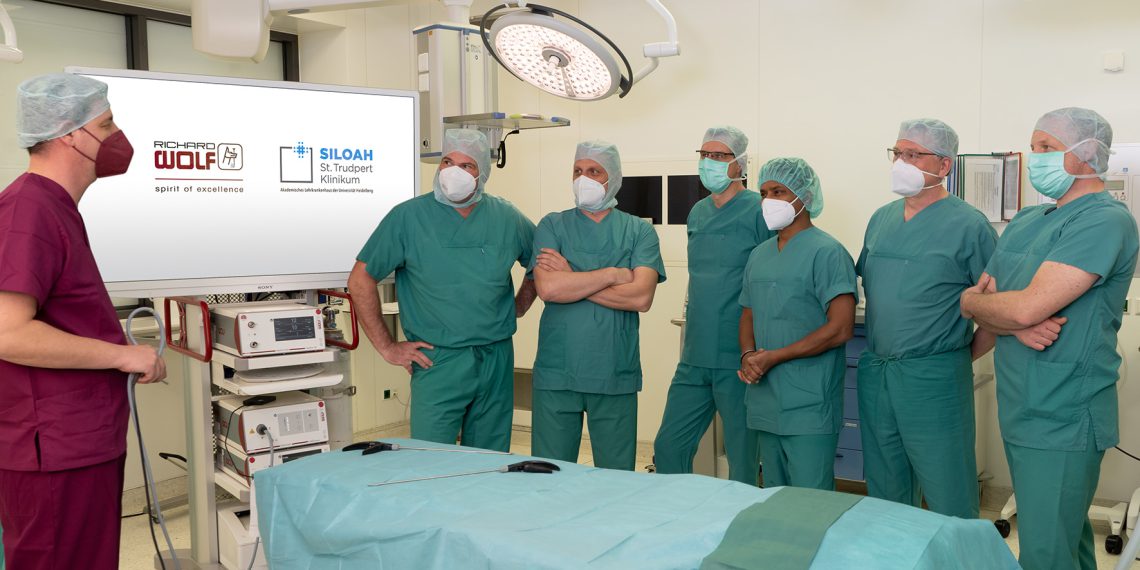In medicine, successes and advances are closely linked to technical innovations. This is particularly true for surgical disciplines, where minimally invasive surgery, so-called keyhole surgery, has now become established. For several decades, Siloah St. Trudpert Klinikum and Richard Wolf, a medical technology company specializing in endoscopy systems, have been working together to advance optimizations.
“We experience first-hand how our instruments support us in our daily operating routine. In direct exchange, the surgeons let us know where they see potential for optimization and what works very well. This is valuable feedback for us, which comes directly from the operating room and is incorporated into further development. For example, the development of the new ERAGONstitch generation of needle holders, from the first hand sample to the final product, was accompanied by PD Dr. Schulz and his entire surgical team.”
- Jürgen Steinbeck, Managing Director
The long-standing, good cooperation is also an important factor for the doctors in their work. Sales representative Matthias Fröhlich from Richard Wolf is a frequent and welcome guest at the hospital. “Technical improvements not only make the surgeons’ work easier and can improve it, they ultimately benefit all patients. Every optimization also increases patient safety,” Matthias Fröhlich summarizes.
A simple but concrete example: the quality of the display on the OR monitor. The clearer the surgical area is transmitted on the screen, the better even small details can be recognized by the surgical team and the safer the procedure can be for the patient. Since the first endoscopic 4K tower with the latest technology and 4K resolution was installed at Siloah St. Trudpert Klinikum back at the end of 2017, the surgeons have had consistently positive experiences. Every day, for example, the team at the Clinic for General, Visceral and Minimally Invasive Surgery uses the 4K surgical towers to perform not only routine operations such as gall bladder removals and hernia operations, but also complex procedures on the stomach, pancreas and lungs.
4K: This means four times the resolution of Full HD. The abbreviation 4K stands for 4,000 and refers to the approximate number of horizontal pixels/images. The result is clear, razor-sharp images at maximum brightness, above-average contrasts and an expanded color spectrum. This display enables a better spatial depth effect and relaxed viewing for the viewer. “The smallest differences and details are made visible — this makes our surgeons’ work immensely easier,” PD Dr. Tim Schulz, Chief Physician of the Clinic for General, Visceral, Thoracic and Minimally Invasive Surgery, is enthusiastic about the high image quality.
“Especially for complex operations on the intestine, liver, lungs or stomach, this technology is the new standard and offers optimal surgical conditions.” In the context of bariatric surgery (surgery to treat morbid obesity), for example, the structures are nevertheless excellently visualized by the modern imaging despite being restricted by obesity. These positive experiences with the endoscopic 4K tower from the Richard Wolf company in Knittlingen have convinced the chief physician and his surgical team to such an extent that 4K technology is standard in the operating rooms at Siloah St. Trudpert Klinikum.
Simply see more
From biopsy forceps to uretheroscopes: gynecological, urological and orthopedic surgery also rely on Richard Wolf instruments. Currently, the team of head physician PD Dr. Schulz is increasingly performing endoscopic procedures using ICG (indocyanine green)-supported fluorescence imaging in real time — also optimized to 4K. This uses green light for detailed image information and improved spatial depth. “In this process, the intravenous administration of a specific substance (ICG) and a special image information processing method provide tissues such as tumors with detailed and high-contrast images, making it easier to distinguish them from healthy tissue,” explains PD Dr. Schulz.
Furthermore, ICG fluorescence can be used to visualize and reproduce the blood flow to structures such as the colon during colorectal surgery. This can reduce the risk of serious complications. “The possibility of highlighting the blood flow and the anatomy even more clearly in this way and displaying them in a focused manner is an additional plus point for surgical work,” Matthias Fröhlich points out. Dr. Ingo Thalmann, head of the gynecological clinic, and Prof. Dr. Stephan Kruck, head of urology, confirm the advantages for their surgical disciplines.
In addition to fluorescence-assisted surgery, the topic of “more vision” is also a major theme in the cooperation between the hospital and Richard Wolf GmbH in the Department of Urology. The “System blue” used in the area of bladder cancer screening enables so-called “blue light diagnostics”, in which the use of fluorescent blue light significantly improves the detection of certain bladder tumors — compared to pure diagnostics under white light. The procedure is called photodynamic diagnostics (PDD) and has been practiced very successfully at the hospital for many years. “Light cells in the tumor cells are activated and appear fluorescent, making them easier for the surgeon to perceive and control during the procedure,” says the chief urologist.
Future-oriented partnership
Impulses for new, future developments and joint projects do not only come from the operating room; events can also provide the impetus, as the example of the Corona pandemic shows. Together with Dr. Thushira Weerawarna, Chief Physician of the Clinic for Pneumology, Respiratory and Sleep Medicine, several digital workshops have taken place since last year. These have covered bronchoscopy with Covid-19 and airway management with the latest generation of flexible sensor bronchoscopes from Richard Wolf. The experience of two pandemic years by Dr. Weerawarna and his team, along with feedback from physician colleagues, gives a very good overall picture. “The goal is to expand such events, digital as well as live, in the future and to conduct bronchoscopy workshops worldwide together with Dr. Weerawarna,” says Jürgen Steinbeck.

















